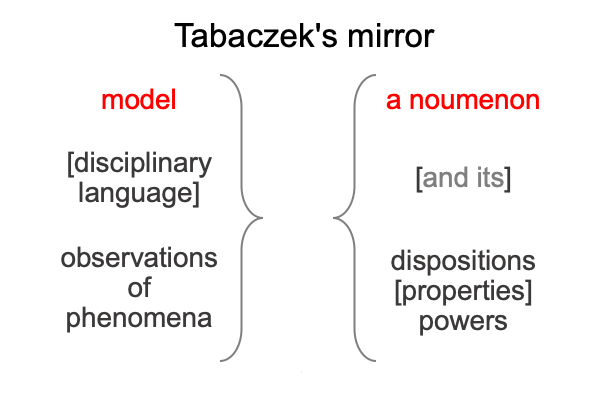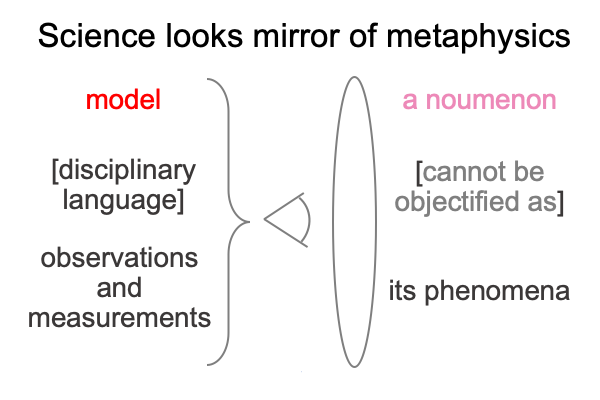0041 Here is another picture of Tabaczek’s mirror. The empirio-schematic side gazes into the noumenal side. The Aristotelian side gazes into the science side. Well, maybe the word, “gazes”, in insufficient. Perhaps, the term, “projects into”, is more insightful.

Both sides express the characteristics of Peirce’s secondness. Each side has two contiguous real elements.
0042 Now, I want to ask a not-so obvious question, “If Tabaczek’s dispositional metaphysics vaporizes the modern positivist intellect for even a standard case of natural science, such as the orthograde (spontaneous) combustion of hydrogen and oxygen gases, then why does he need to wrestle with the issue of emergence?”
I suspect the answer comes from the ghost that the science side sees in Tabaczek’s mirror.
Here is a picture.

0043 The slogan on the right may be attributed to the philosopher, Immanuel Kant (1724-1804 AD), in a sloppy academic manner. That is one of the beauties of slogans. Slogans are always sloppy in a satisfying sort of way. If a noumenon [cannot be objectified as] its phenomena, then why worry about the thing itself? Scientists routinely ignore the thing itself. Some scientists are even hostile to noumena and indignant when metaphysicians wonder about them.
0044 Tabaczek touches upon this awkwardness in section 1.6.2.5, titled “Scientific Realism”.
He writes (more or less), “Scientific realism is embraced by the vast majority of philosophers of science, who assume that our best models correctly describe observable, measurable, and mind-independent aspects of reality. As such, if a model replaces its corresponding noumenon, then so much the better.”
Against triumphalist science, where a model gets placed on the throne of the thing itself, Kant reminds us that models can be wrong. So, Kant’s slogan protects the integrity of the thing itself against the assumption that the model is the only point of illumination in the Positivist’s judgment.
0045 But, there is a drawback.
Kant retains the integrity of the noumenon at the cost of fixing the definition of phenomena. Phenomena are defined as the observable and measurable facets of the thing itself. So, the what is of phenomena (in the Positivist’s judgment) is strongly coupled to the what is of observations and measurements in the empirio-schematic judgment. This couplingconstructs a tautology that preserves the positivist intellect.
0046 This drawback should be nullified when Tabaczek argues that the noumenon is the encountered thing and its phenomena manifest the thing’s dispositions and powers.
The positivist intellect should vaporize.
But, positivist intellect turns into a ghost.
The ghost clouds what the science side sees in Tabaczek’s mirror.
So, Tabaczek turns to the field of emergence, where science does not readily overlay a model onto the noumenon of emergent phenomena.
